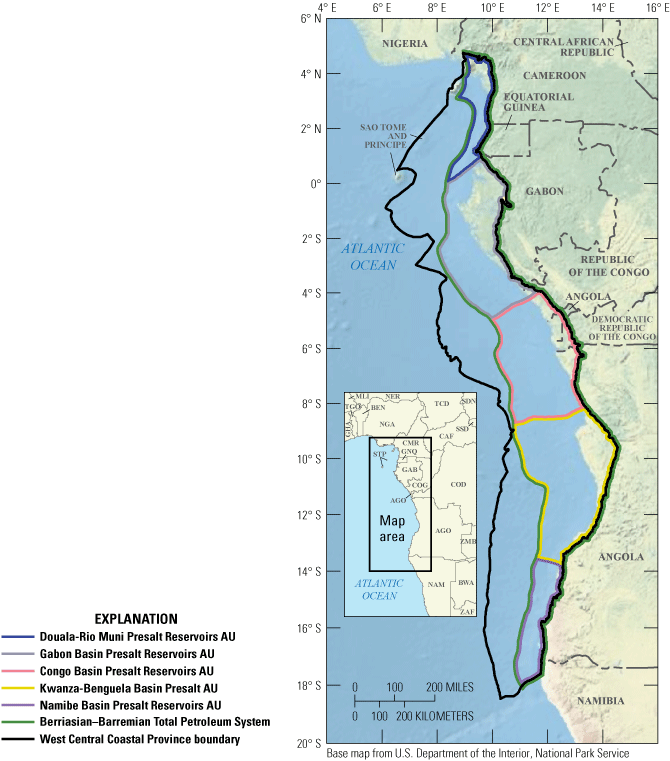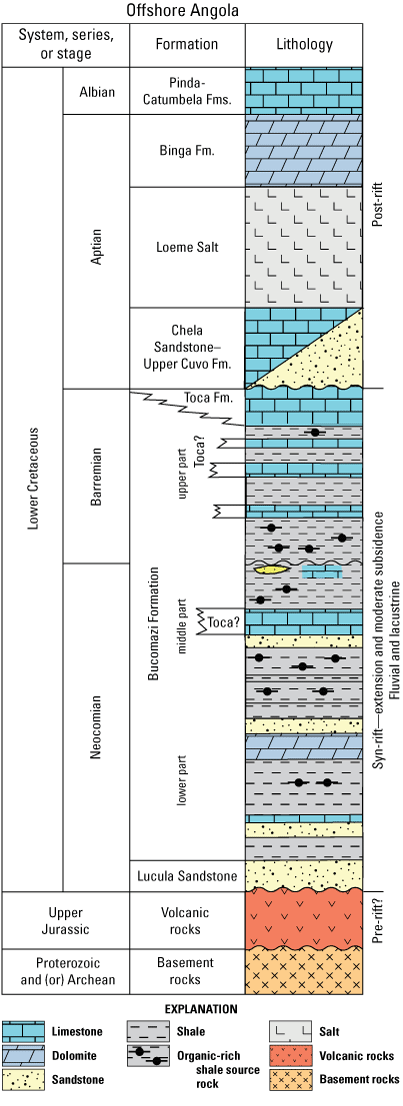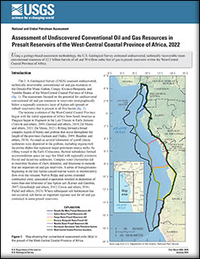Assessment of Undiscovered Conventional Oil and Gas Resources in Presalt Reservoirs of the West-Central Coastal Province of Africa, 2022
Links
- Document: Report (1.86 MB pdf) , HTML , XML
- Data Release: USGS data release - USGS National and Global Oil and Gas Assessment Project—West-Central Coastal Province (Africa) Presalt: Assessment Unit Boundaries, Assessment Input data, and Fact Sheet Data Tables
- Download citation as: RIS | Dublin Core
Abstract
Using a geology-based assessment methodology, the U.S. Geological Survey estimated undiscovered, technically recoverable mean conventional resources of 12.1 billion barrels of oil and 50 trillion cubic feet of gas in presalt reservoirs within the West-Central Coastal Province of Africa.
Introduction
The U.S. Geological Survey (USGS) assessed undiscovered, technically recoverable, conventional oil and gas resources in the Douala-Rio Muni, Gabon, Congo, Kwanza-Benguela, and Namibe Basins of the West-Central Coastal Province of Africa (fig. 1). The assessment focused on the potential for undiscovered conventional oil and gas resources in reservoirs stratigraphically below a regionally extensive layer of Aptian salt (presalt or subsalt reservoirs) that is present in all five basins (fig. 2).

Map showing five conventional assessment units (AUs) in the presalt of the West-Central Coastal Province of Africa.

Generalized stratigraphic column showing ages, formation and member names, hydrocarbon source rocks, and tectonic stages for the Lower Cretaceous in the Kwanza Basin, offshore Angola. The Aptian Loeme Salt separates presalt strata from postsalt strata. The Bucomazi Formation and equivalents are the main hydrocarbon source rocks in the West Central Coastal Province. Modified from Brownfield and Charpentier (2006). (Fm., Formation; Fms., Formations)
The tectonic evolution of the West-Central Coastal Province began with the initial separation of Africa from South America as Pangaea began to fragment in the Late Triassic to Early Jurassic (Torsvik and others, 2009; Guiraud and others, 2010; De Matos and others, 2021; De Matos, 2021). Rifting formed a broad complex region of horsts and grabens that occur throughout the length of the province (Jackson and Hudec, 2009; Baudino and others, 2018). As much as several kilometers of synrift clastic sediments were deposited in the grabens, including organic-rich lacustrine shales that represent major petroleum source rocks. As rifting waned in the Early Cretaceous, thermal subsidence formed accommodation space (or sag) that filled with regionally extensive fluvial and lacustrine sediments. Complex water chemistries led to microbial fixation of chert, dolomite, and limestone in mounds that are important oil and gas reservoirs. A series of transgressions beginning in the late Aptian caused marine waters to intermittently flow over the volcanic Walvis Ridge and across extended continental crust; associated evaporation resulted in deposition of more than one kilometer of late Aptian salt (Karner and Gambôa, 2007; Greenhalgh and others, 2012; Cowie and others, 2016; Pichel and others, 2023). Where subsequent salt halokenesis has not occurred, salt forms an important regional seal for oil and gas contained in some presalt reservoirs.
Total Petroleum System and Assessment Units
The USGS defined a Berriasian–Barremian Lacustrine Total Petroleum System (TPS) within the presalt stratigraphic section and five conventional assessment units (AUs) within this TPS (fig. 1). The five conventional AUs in general share similar petroleum source rocks, reservoirs rocks, traps, seals, and timing of oil and gas generation (Beglinger and others, 2012). The main petroleum source rocks are Berriasian–Barremian synrift organic-rich lacustrine shales with total organic carbon (TOC) content as much as 20 weight percent, hydrogen index values as much as 800 milligrams hydrocarbon per gram of TOC and thickness as much as 600 meters (Brownfield and Charpentier, 2006; Greenhalgh and others, 2012). Synrift reservoirs in this TPS include alluvial-fluvial conglomerates and sandstones, and marginal lacustrine to deep-water lacustrine sandstones. Reservoirs in the overlying sag section are extensive fluvial and lacustrine sandstones and an unusual type of reservoir related to microbial deposition from chemically complex waters (Saller and others, 2016; Cui and others, 2023; Moragas and others, 2023). Detailed descriptions of these microbial reservoirs have also been published from occurrences in the age-equivalent rocks in the Santos Basin of Brazil (Cazier and others, 2014; Farias and others, 2019; Gomes and others, 2020). These reservoirs typically form mounds or build ups composed of microbially deposited chert, dolomite, and limestone, in which the cherts and dolomites may exhibit excellent porosity and permeability. Traps in the TPS are formed by facies changes within the synrift section, by draping of sandstones over horsts, by reservoirs adjacent to tilted fault blocks, and by stratigraphic traps formed by microbial mounds within the sag section. Seals are provided by intraformational mudstones within the synrift section and by evaporites overlying the sag reservoirs. Oil generation may have begun from synrift lacustrine shales in the Aptian, and gas generation may have begun in the Oligocene (Brownfield and Charpentier, 2006). Assessment input data are summarized in table 1 and in Schenk (2024).
Table 1.
Key input data for five conventional assessment units in the presalt of the West Central Province of Africa.[Shading indicates not applicable. AU, assessment unit; MMBO, million barrels of oil; BCFG, billion cubic feet of gas]
Undiscovered Resources Summary
The USGS quantitatively assessed oil and gas resources in five conventional AUs in basins of the West-Central Coastal Province of Africa (table 2). For undiscovered, technically recoverable continuous oil and gas resources, the mean totals are 12,104 million barrels of oil (MMBO), or 12.1 billion barrels of oil, with an F95 to F5 fractile range from 4,221 to 26,433 MMBO; 49,977 billion cubic feet of gas (BCFG), or 50 trillion cubic feet of gas, with an F95 to F5 fractile range from 17,121 to 109,925 BCFG; and 2,634 million barrels of natural gas liquids (MMBNGL), or 2.6 billion barrels, with an F95 to F5 fractile range from 882 to 5,841 MMBNGL.
Table 2.
Assessment results for five conventional assessment units in the presalt of the West Central Coastal Province of Africa.[Results shown are fully risked estimates. F95 represents a 95-percent chance of at least the amount tabulated; other fractiles are defined similarly. Shading indicates not applicable. AU, assessment unit; MMBO, million barrels of oil; BCFG, billion cubic feet of gas; BCFG, billion cubic feet of gas; NGL, natural gas liquids; MMBNGL, million barrels of natural gas liquids]
For More Information
Assessment results are also available at the U.S. Geological Survey Energy Resources Program website, https://www.usgs.gov/programs/energy-resources-program.
West-Central Coastal Province Assessment Team
Christopher J. Schenk, Tracey J. Mercier, Cheryl A. Woodall, Phuong A. Le, Andrea D. Cicero, Ronald M. Drake II, Geoffrey S. Ellis, Thomas M. Finn, Michael H. Gardner, Sarah E. Gelman, Jane S. Hearon, Benjamin G. Johnson, Jenny H. Lagesse, Heidi M. Leathers-Miller, Kristen R. Marra, Kira K. Timm, and Scott S. Young
References Cited
Baudino, R., Pontet, M., Manus, M., Herra, A., Sanders, C., Badali, M., Tocco, R., Martinez, S., Tritlla, J., Loma, R., Carrasco, A., Padron, S., and Mora, S., 2018, Modeling petroleum systems of hyperextended margins–Angola case study: American Association of Petroleum Geologists Search and Discovery Article No. 30591, 23 p., accessed on August 19, 2022, at https://www.searchanddiscovery.com/pdfz/documents/2018/30591baudino/ndx_baudino.pdf.html.
Beglinger, S.E., Doust, H., and Cloetingh, S., 2012, Relating petroleum system and play development to basin evolution—West African South Atlantic basins: Marine and Petroleum Geology, v. 30, no. 1, p. 1–25, accessed August 19, 2022, at https://doi.org/10.1016/j.marpetgeo.2011.08.008.
Brownfield, M.E., and Charpentier, R.R., 2006, Geology and total petroleum systems of the West-Central Coastal Province (7203), West Africa: U.S. Geological Survey Bulletin 2207–B, 52 p., accessed on August 19, 2022, at https://doi.org/10.3133/b2207B.
Cazier, E.C., Bargas, C., Buambua, L., Cardoso, S., Ferreira, H., Inman, K., Lopes, A., Nicholson, T., Olson, C., Saller, A., and Shinol, J., 2014, Petroleum geology of Cameia Field, deepwater pre-salt Kwanza Basin, Angola, West Africa: American Association of Petroleum Geologists Search and Discovery Article No. 20275, 11 p., accessed on August 19, 2022, at https://www.searchanddiscovery.com/documents/2014/20275cazier/ndx_cazier.pdf.
Cowie, L., Angelo, R.M., Kusznir, N.J., Manatschal, G., and Horn, B., 2016, The paleo-bathymetry of base Aptian salt deposition on the northern Angolan rifted margin—Constraints from flexural back-stripping and reverse post-break-up thermal subsidence modelling: Petroleum Geoscience, v. 22, p. 59–70, accessed on September 11, 2023, at https://doi.org/10.1144/petgeo2014-087.
Cui, X., Wignall, B., Freeman, K.H., and Summons, R.E., 2023, Early Cretaceous marine incursions into South Atlantic rift basins originated from the south: Communications Earth and Environment, v. 4, no. 6, 11 p., accessed on September 11, 2023, at https://doi.org/10.1038/s43247-022-00668-3.
De Matos, R.M.D., 2021, Magmatism and hotspot trails during and after continental break-up in the South Atlantic: Marine and Petroleum Geology, v. 129, 24 p., accessed on August 19, 2022, at https://doi.org/10.1016/j.marpetgeo.2021.105077.
De Matos, R.M.D., Krueger, A., Norton, I., and Casey, K., 2021, The fundamental role of the Borborema and Benin-Nigeria provinces of NE Brazil and NW Africa during the development of the South Atlantic Cretaceous Rift System: Marine and Petroleum Geology, v. 127, article 104872, 30 p., accessed on August 19, 2022, at https://doi.org/10.1016/j.marpetgeo.2020.104872.
Farias, F., Szatmari, P., Bahniuk, A., and Franca, A.B., 2019, Evaporitic carbonates in the pre-salt of Santos Basin–Genesis and tectonic implications: Marine and Petroleum Geology, v. 105, p. 251–272, accessed August 19, 2022, at https://www.sciencedirect.com/science/article/pii/S0264817221003044.
Gomes, J.P., Bunevich, R.B., Tedeshi, L.R., Tucker, M.E., and Whitaker, F.F., 2020, Facies classification and pattern of lacustrine carbonate deposition of the Barra Velha Formation, Santos Basin, Brazilian Pre-Salt: Marine and Petroleum Geology, v. 113, article 104176, 21 p., accessed on August 19, 2022, at https://doi.org/10.1016/j.marpetgeo.2019.104176.
Greenhalgh, J., Borsato, R., Methew, F., Duncan-Jones, G., Pimenta, I., Marques de Silva, J., and Narciso de Silva, L., 2012, Petroleum plays and prospectivity in the Kwanza and Benguela basins of offshore Angola: American Association of Petroleum Geologists Search and Discovery Article No. 10443, 7 p., accessed on August 19, 2022, at https://www.searchanddiscovery.com/documents/2012/10443greenhalgh/ndx_greenhalgh.pdf.
Guiraud, M., Buta-Neto, A., and Quesne, D., 2010, Segmentation and differential post-rift uplift at the Angola margin as recorded by the transform-rifted Benguela and oblique-to-orthogonal-rifted Kwanza basins: Marine and Petroleum Geology, v. 27, no. 5, p. 1040–1068, accessed August 19, 2022, at https://doi.org/10.1016/j.marpetgeo.2010.01.017.
Jackson, M.P., and Hudec, M., 2009, Interplay of basement tectonics, salt tectonics, and sedimentation in the Kwanza Basin, Angola: American Association of Petroleum Geologists Search and Discovery Article No. 30091, 26 p., accessed on August 19, 2022, at https://www.searchanddiscovery.com/documents/2009/30091jackson/ndx_jackson.pdf.
Karner, G.D., and Gambôa, A.P., 2007, Timing and origin of the South Atlantic pre-salt sag basins and their capping evaporites, in Schreiber, B.C., Lugli, S., and Babel, eds., Evaporites in space and time: London, Geological Society of London Special Publications, v. 285, p. 15–35, accessed on September 11, 2023, at https://doi.org/10.1144/SP285.2.
Moragas, M., Basqués, V., Martín-Martín, J.D., Sharp, I., Lapponi, F., Hunt, D., Zeller, M., Vergés, J., Messager, G., Gindre-Channu, L., Swart, R., and Machado, V., 2023, Paleoenvironmental and diagenetic evolution of the Aptian pre-salt succession in Namibe Basin (Onshore Angola): Marine and Petroleum Geology, v. 150, 106153, 27 p., accessed on September 11, 2023, at https://doi.org/10.1016/j.marpetgeo.2023.106153.
Pichel, L.M., Legeay, E., Ringenbach, J-C., and Callot, J-P, 2023, The West African salt-bearing rifted margin—Regional structural variability and salt tectonics between Gabon and Namibe: Basin Research, 31 p., accessed on September 11, 2023, at https://doi.org/10.1111/bre.12796.
Schenk, C.J., 2024, USGS National and Global Oil and Gas Assessment Project—West Central Coastal Province assessment unit boundaries, assessment input data, and fact sheet data tables: U.S. Geological Survey data release, https://doi.org/10.5066/P9E3JNPI.
Torsvik, T.H., Rousse, S., Labails, C., and Smethurst, M.A., 2009, A new scheme for the opening of the South Atlantic Ocean and the dissection of an Aptian salt basin: Geophysical Journal International, v. 177, no. 3, p. 1315–1333, accessed August 19, 2022, at https://doi.org/10.1111/j.1365-246X.2009.04137.x.
Disclaimers
Any use of trade, firm, or product names is for descriptive purposes only and does not imply endorsement by the U.S. Government.
Although this information product, for the most part, is in the public domain, it also may contain copyrighted materials as noted in the text. Permission to reproduce copyrighted items must be secured from the copyright owner.
Suggested Citation
Schenk, C.J., Mercier, T.J., Woodall, C.A., Le, P.A., Cicero, A.D., Drake, R.M., II, Ellis, G.S., Finn, T.M., Gardner, M.H., Gelman, S.E., Hearon, J.S., Johnson, B.G., Lagesse, J.H., Leathers-Miller, H.M., Marra, K.R., Timm, K.K., and Young, S.S., 2024, Assessment of undiscovered conventional oil and gas resources in presalt reservoirs of the West-Central Coastal Province of Africa, 2022: U.S. Geological Survey Fact Sheet 2023–3028, 4 p., https://doi.org/10.3133/fs20233028.
ISSN: 2327-6932 (online)
| Publication type | Report |
|---|---|
| Publication Subtype | USGS Numbered Series |
| Title | Assessment of undiscovered conventional oil and gas resources in presalt reservoirs of the West-Central Coastal Province of Africa, 2022 |
| Series title | Fact Sheet |
| Series number | 2023-3028 |
| DOI | 10.3133/fs20233028 |
| Publication Date | January 29, 2024 |
| Year Published | 2024 |
| Language | English |
| Publisher | U.S. Geological Survey |
| Publisher location | Reston VA |
| Contributing office(s) | Central Energy Resources Science Center |
| Online Only (Y/N) | Y |


